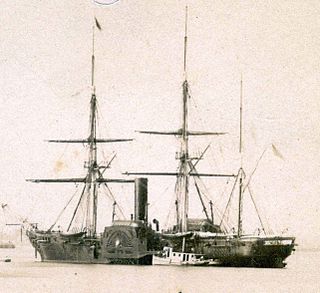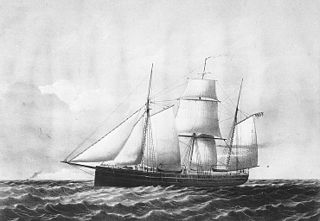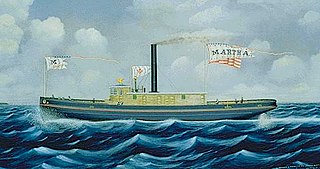
The first USSSassacus, a wooden, double-ended, side-wheel steamer, was launched on 23 December 1862 by the Portsmouth Navy Yard in Kittery, Maine, sponsored by Miss Wilhelmina G. Lambert. Sassacus was commissioned at the Boston Navy Yard on 5 October 1863, Lieutenant Commander Francis A. Roe in command.

USS Susquehanna, a sidewheel steam frigate, was the first ship of the United States Navy to be named for the Susquehanna River, which rises in Lake Otsego in central New York and flows across Pennsylvania and the northeast corner of Maryland emptying into the Chesapeake Bay.

USS Stars and Stripes (1861) was a 407-ton steamer acquired by the U.S. Navy and put to use by the Union during the American Civil War.

The first USS Monticello was a wooden screw-steamer in the Union Navy during the American Civil War. She was named for the home of Thomas Jefferson. She was briefly named Star in May 1861.

USS Niphon was a steam operated vessel acquired by the Union Navy during the American Civil War. She was used by the Navy to patrol navigable waterways of the Confederacy to prevent the South from trading with other countries.

USS Albatross (1858) was a screw steamer rigged as a three-masted schooner acquired by the Union Navy during the beginning of the American Civil War. She was outfitted as a gunboat with heavy guns and used in the Union blockade of the waterways of the Confederate States of America.
USS Wilderness was a wooden-hulled, side-wheel steamship in the United States Navy during the American Civil War. After the war, she served as a revenue cutter. In 1873, she was renamed John A. Dix for former Secretary of the Treasury John Adams Dix.

USS Unadilla was a Unadilla-class gunboat built for service with the United States Navy during the American Civil War. She was the lead ship in her class.

The USS Cherokee was a 606-ton screw steam gunboat in the US Navy during the American Civil War ship. The ship later served in the Chilean Navy.
USS Young America (1855) was a Confederate steamer captured by the Union Navy’s blockade vessels, and subsequently placed in-service in the Union Navy during the American Civil War.
USS Underwriter (1852) was a 341-ton sidewheel steamer that was purchased for military use by the Union Navy during the American Civil War.
USS Shawsheen was a steam operated tugboat acquired by the Union Navy during the American Civil War.
USS Berberry (1864) was a steam-powered tugboat acquired by the Union Navy during the American Civil War. She was used by the Navy to patrol navigable waterways of the Confederacy to prevent the South from trading with other countries.

The USS Harvest Moon was a steam operated gunboat acquired by the Union Navy during the American Civil War. She was used by the Navy to patrol navigable waterways of the Confederacy to prevent the South from trading with other countries.
The first USS Calypso was a steamer captured by the Union Navy during the American Civil War.
USS Britannia (1862) was a steamer captured by the Union Navy during the American Civil War. She was used by the Union Navy as a gunboat and patrol vessel in support of the Union Navy blockade of Confederate waterways.
USS State of Georgia was a large steamer with powerful guns acquired by the Union Navy during the American Civil War. State of Georgia, with her crew of 113 sailors and officers, was used by the Union Navy as a gunboat in support of the Union Navy blockade of Confederate waterways.
The third USS Union was a heavy (1,114-ton) steamer with a powerful 12-inch rifled gun purchased by the United States Navy during the American Civil War.

USS Violet was a 166-ton steamer acquired by the U.S. Navy for use during the American Civil War.

Gustavus Hall Scott was an officer in the United States Navy who served in the Second Seminole War and the American Civil War. He rose to the rank of rear admiral and late in his career was commander-in-chief of the North Atlantic Squadron.










